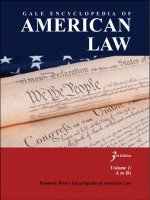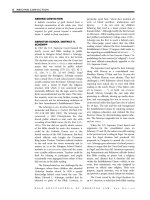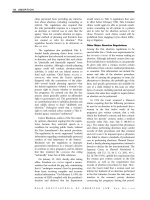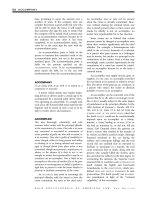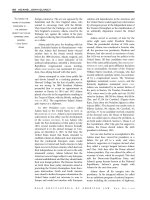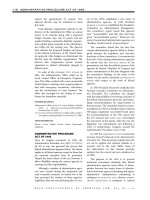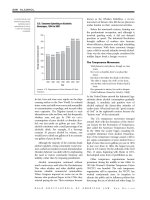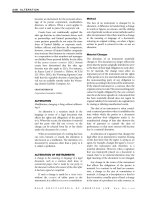Gale Encyclopedia Of American Law 3Rd Edition Volume 2 P4 pps
Bạn đang xem bản rút gọn của tài liệu. Xem và tải ngay bản đầy đủ của tài liệu tại đây (783.62 KB, 10 trang )
His REAL ESTATE purchases were made
possible by a growing and successful law
practice. By 1834 he had secured his place in
the local legal community through a joint
publishing venture with Thomas Slidell. Their
Digest of the Reported Decisions of the Superior
Court of the Late Territory of Orleans and of the
Supreme Court of Louisiana was widely used.
Benjamin’s national reputation as a lawyer
was established by his participation in a case
involving the brig Creole. His brief—which
reviewed the status of
SLAVERY under both
INTERNATIONAL LAW and U.S. domestic law—was
printed as a pamphlet and widely circulated. In
this more liberal period of his life, he believed
and argued that slavery was against the laws of
humans and nature. He would later reverse his
position.
Benjamin began his political career in 1842
when he was elected as the Whig candidate to
the lower house of the Louisiana Legislature. He
attended the Louisiana Constitutional Conven-
tion from 1844 to 1845. Benjamin’s wife was
not supportive of his interest in politics, or
tolerant of his abs ences. In 1845, after eleven
years of
MARRIAGE, she moved to Paris. The
couple rarely lived together again as
HUSBAND
AND WIFE
, but they never divorced—and Benja-
min’s lifelong devotion to his wife has been well
documented.
After his wife’s departure, Benjamin
retreated to his plantation, from 1845 to 1848,
and began to experiment with sugar chemistry
and processing. Ultimately, he lost the planta-
tion when a friend defaulted on a note that
Benjamin had signed.
Despite his business reversals, Benjamin had
“great dreams about the future development of
American commerce ” and found himself with a
renewed commitment to political service. He
shared a growing belief in the South that foreign
commerce would strengthen the region and
restore the balance of power lost by the
COMPROMISE OF 1850. In 1852 Benjamin ran as
a
WHIG PARTY candidate for one of Louisiana’s
U.S. Senate seats.
His successful bid for office made him the
nation’s first Jewish U.S. senator. Also in 1852,
Benjamin was nominated to the U.S. Supreme
Court by President
MILLARD FILLMORE. Preferring
to take his seat in the Senate, Benjamin declined
Fillmore’s offer and thereby missed the oppor-
tunity to be the first Jewish Supreme Court
justice. Benjamin also turned down an appoint-
ment as ambassador to Spain, in 1853. Mindful
of the escalating national conflict between
North and South, he wanted to stay in the
United States. In 1854 he wrote, “[A] gulf is
already opened between the Northern and
Southern Whigs. God knows what awaits
us. The future looks full of gloom to me.”
Judah Philip
Benjamin.
PUBLIC DOMAIN.
Judah Philip Benjamin 1811–1884
◆◆◆◆◆◆◆◆◆
❖❖
1811 Born, St.
Croix, British
West Indies
1813 Family
immigrated to
Charleston, S.C.
1827 Moved to
Louisiana
1842 Elected
to Louisiana
Legislature
1852 Elected first
Jewish U.S. senator
1861 Appointed attorney
general of the Confederacy
1861–65
U.S. Civil War
1862–65 Served as secretary
of state of the Confederacy
1865 Fled to England to
avoid post-war proscecution
1872 Selected
as Queen's
counsel
1866 Admitted to English
bar at Lincoln's Inn
1883 Retired
to France
1884 Died,
Paris, France
▼▼
▼▼
1825
1800
1850
1875
1900
GALE ENCYCLOPEDIA OF AMERICAN LAW, 3RD E DITION
18 BENJAMIN, JUDAH PHILIP
In 1856 Benjamin left the Whig party and
joined the more conservativ e southern Demo-
crats. He was reelected to the Senate and
continued to serve Louisiana there until the
CIVIL WAR. Following the election of ABRAHAM
LINCOLN
in 1860, Benjamin advised secession; he
resigned his Senate seat when Louisiana voted to
leave the Union.
Benjamin was named attorney general of the
Confederate States of America in early 1861. He
served as attorney general until November 21,
1861, when he became secretary of war. He
inherited a war department that was disorga-
nized and deeply in debt. Throughout 1862, the
Confederacy suffered both human resource and
equipment shortages, and severe casualties.
A plan by Benjamin to build troop strength by
drafting slaves—with the promise of emancipa-
tion for service—was prepared and sent to the
Confederate congress. Seeing the initiative as a
threat to the principle of slavery, the congress
failed to pass the measure. Benjamin was eventu-
ally charged with inefficiency, and a motion to
remove him from his post was drafted.
President Davis, still confident in Benja-
min’s abilities, stepped in and appointed him
SECRETARY OF STATE on March 18, 1862. Benjamin
served in that capacity until the fall of the
Confederacy, but he never fully regained his
popularity with the Southern people. Viewed in
an historical context, Benjamin’s service and
loyalty to the Confederacy are extraordinary and
commendable—especially in light of the ex-
treme anti-Semitism and hatred that pervaded
the South throughout the war years.
After Robert E. Lee’s surrender to
ULYSSES S.
GRANT at Appomattox Courthouse on April 9,
1865, U.S. agents targeted Benjamin for capture
because it was assumed, falsely, that he knew the
location of la rge sums of money. After a brief
stop in North Carolina, Benjamin headed south
to Florida. Garbed as a Frenchman and
speaking fluent French, he passed himself off
as a journalist, Monsieur Bonfals (which
translates as Mr. Good Disguise). Because
Benjamin was too fat to ride a horse, he
traveled by cart in the company of a former
Confederate officer from New Orleans who
pretended to be his interpreter.
On May 1, 1865, federal agents increased their
efforts to locate all Confederate fugitives, and the
New York Times called for Jefferson Davis, Judah
Benjamin, and Confederate secretary of war John
C. Breckenridge to die “the most disgraceful death
on the gallows.” The price on Benjamin’sheadwas
$40,000, dead or alive. But by May, Benjamin had
already made it to Tampa.
With the help of Confederate sympathizers
and former Confederate soldiers, Benjamin
traveled from Tampa to the Gamble Mansion
on Florida’s southwest coast. En route, he
presented himself as Mr. Howard, a farmer
and cattle buyer. With federal troops closing in,
he was twice forced to hide in a canebrake near
the mansion to avoid capture. Eventually,
Benjamin was moved to Sarasota Bay, where
he sailed down the coast to Knight’s Key with
Captain Frederick Tresca, a former blockade
runner, and H. A. McLeod, an experienced
sailor for hire. The trio reached Knight’s Key on
July 7, 1865. From there, Benjamin boarded a
boat for Bimini, in the Bahamas. After this
vessel was shipwrecked, he was rescued and
returned to Florid a, where he again faced
capture by federal agents. Benjamin eventually
reached Bimini, and then set sail for England.
He arrived in England on August 30, 1865, after
almost five months of dangerous and grueling
travel.
Without funds, Benjamin made the neces-
sary arrangements to practice law in England.
He was admi tted to the bar at Lincoln’s Inn in
1866, and he was soon a respected member of
the British bar. Most of his cases focused on
corporate law. He also wrote about matters
pertaining to business and corporate law. His
Treatise on the Law and Sale of
PERSONAL
PROPERTY
: With Special Reference to the American
Decisions and the French Code and Civil Law was
published in 1868. Commonly known as
Benjamin on Sales, the book was a definitive
source on commercial matters on both sides of
the Atlantic for the next twenty-five years. In
1872, Benjamin was selected Queen’s Counsel.
He practiced law in England until 1883, when
he retired to France. He is credited with making
major contributions to the British Empire’s
dominance of world trade in the last half of the
nineteenth century.
Benjamin died May 6, 1884, in Paris. He was
buried at the Pere Lachaise Cemetery under a
headstone marked Philippe Benjamin.
FURTHER READINGS
Curran, Charles. “The Three Lives of Judah P. Benjamin.”
1967. History Today 17, no. 9.
THE NATION WHICH
PRESENTS ITSELF
WITH AN ORGANIZED
GOVERNMENT AND
INSTITUTIONS
CREATED BY THE FREE
WILL OF THE CITIZENS
[MAY] DEMAND
ITS RIGHT
RECOGNITION
.
—JUDAH BENJAMIN
GALE ENCYCLOPEDIA OF AMERICAN LAW, 3RD E DITION
BENJAMIN, JUDAH PHILIP 19
Evans, Eli N., and Robert Weinberg. 1988. Judah P.
Benjamin: The Jewish Confederate. New York: Free
Press.
Field, Martha A. “The Differing Federalisms of Canada and
the United States.” Law and Contemporary Problems 55.
Ginsburg, Ruth Bader. “From Benjamin to Brandeis to
Breyer: Is There a Jewish seat?” 2002. Brandeis Law
Journal 41 (winter).
“Journey to Asylum.” 1987. Civil War Times Illustrated 26,
vol. 8 (December).
“Judah P. Benjamin’s Loyalty to Jefferson Davis.” 1966.
Georgia Review 20, vol. 3.
Krause, Allen. “The Enigmatic Judah Benjamin.” 1978.
Midstream 24, no. 8.
“Meeting Mr. Benjamin.” 1986. Queen City Heritage 44, vol.
3 (fall).
Naresh, Suman. 1996. “Judah Philip Benjamin at the English
Bar.” Tulane Law Review 70 (June).
Patrick, Rembert W. 1950. The Opinions of the Confederate
Attorneys General, 1861–1865. Buffalo: Dennis.
Preisser, Thomas M. “The Virginia Decision to Use Negro
Soldiers in the Civil War, 1864–1865.” 1975. Virginia
Magazine of History and Biography 83, no. 1. Available
online at website
home page: (accessed July 7,
2009).
Sanchez, John E. 1991. “Religious Affirmative Action in
Employment: Fearful Symmetry.” Detroit College of Law
Review.
Sarna, Jonathan D. “The Spectrum of Jewish Leadership in
Ante-Bellum America.” 1982. Journal of American
Ethnic History 1, no. 2.
Schene, Michael G. 1982. The Daring Escape of Judah P.
Benjamin. Tampa, FL: Tampa Bay History.
Wacholder, Ben Zion. “Some Legal and Political Views of
Judah P. Benjamin.
” 1956. Historica Judaica 18, no. 1.
v
BENJAMIN, PARK
Park Benjamin was an eminent patent lawyer
and author.
Benjamin was born May 11, 1849. A
graduate of the U.S. Naval Academy in 1867,
he left the Navy in 1869 and earned a bachelor
of laws degre e from Albany Law School in 1870.
From 1872 to 1878, Benjamin was associate
editor of the Scientific American and became
editor in chief of Appleton’s Cyclopædia of
Applied Mechanics in 1893. Benjamin wrote
The United States Naval Academy (1900) and
numerous essays and naval articles for various
periodicals. He died August 21, 1922, in New
York City.
v
BENTHAM, JEREMY
Described as a philosopher, jurist, and reformer,
Jeremy Bentham is possibly best known as one
of the leading proponents of utilitarianism.
Although he was a devoted scholar who spent
much of his life writing about legal reform, he
published little. Regardless, Bentham had a
profound effect on the politics of his day,
influenced many of his contemporaries (includ-
ing eminent British philosopher
JOHN STUART
MILL
), and introduced a number of terms and
definitions, which are still used today in the
study of philosophy, economics, and politics.
Bentham was born February 15, 1748, in
Houndsditch, near London, into a family of
attorneys. He was educated at Oxford and
admitted to the bar, but decided not to follow in
the footsteps of his father and grandfather.
Instead of practicing law, Bentham chose to
pursue a career in legal, political, and social
reform, applying principles of ethical philoso-
phy to these endeavors.
He was greatly influenced by the work of
Claude-Adrien Helvétius, a French philosopher
who believed t hat a ll pe rsons are intellectua lly
Park Benjamin 1849–1922
◆
◆◆
◆
◆
◆
◆
◆
❖
❖
1849 Born,
New York City
1860 Lenoir constructed the first
internal combustion engine
1861–65
U.S. Civil War
1867 Graduated from
U.S. Naval Academy
1870 Received bachelor of laws
from Albany Law School (NY)
1872–78 Worked
as associate
editor at
Scientific
American
1879 Edison invented the
incandescent light bulb
1893 Became editor in chief at
Appleton's Cyclopaedia of
Applied Mechanics
1898 A History of
Electricity published
1888 Eastman
introduced the
"Kodak" box camera
1908 Henry
Ford
introduced
the Model T
1922 Died,
New York City
1914–18
World War I
▼▼
▼▼
1850
1925
1900
1875
GALE ENCYCLOPEDIA OF AMERICAN LAW, 3RD E DITION
20 BENJAMIN, PARK
equal and that differences arise solely from e duca-
tional opportunities. Helvetius also formulated
a theory t hat good is measured by the degree of
self-contentment experienced by a person, and
that self-interest is the compelling force for all
action. This l atter belief had a profound effect
on Bentham, who incorporated the idea in
the formulation of the basic principles of
utilitarianism.
In 1789 Bentham gained public attention
with the publication of his Introduction to the
Principles of Morals and Legislation, which set
forth his fundamental principles. He believed
that the greatest happiness for the greatest
number is the basis of morality. Happiness and
pleasure were the same, and included social,
intellectual, and moral as well as physical
pleasures. According to Bentham, each pleasure
has certain characteristics, including intensity
and duration, and he established a scale of
measurement to judge the worth of a plea sure
or a pain. Bentham further opined that each
person strives to do what makes him or her
happiest. The happiness of an individual and
the
GENERAL WELFARE are complementary; the
achievement of the greate st amount of happi-
ness is the goal of morality.
Bentham applied his views to reform legisla-
tion, feeling that the purpose of the law was to
maximize total happiness within the limitations
of government. As a result, he achieved great
advances in prison reform,
CRIMINAL LAW, CIVIL
SERVICE
, and insurance and was active in the
compilation of laws into comprehensible text.
Bentham is particularly noted for his
theories of punishment. He claimed that all
punishment required justification, because he
believed that all punishment is inherently evil.
Bentham also believed that to a utilitarian such
as himself, real justice is less important than
apparent justice. In other words, Bentham
believed that seeing justice done is more
important than justice actually being done.
Influenced by the work of Italian philosopher
Cesare Beccaria, Bentham formed some harsh
notions of punishment, such as his belief that in
certain cases torture could be justified. He wrote
that punishment was a relatively weak disincentive
against recidivism, and that there is always a risk
that an offender will commit another offense. He
suggested that torture removes this risk because
torture ceases immediately when a subject com-
plies with the demands of authority. Of course,
this idea discounts the question of whether the
subject can in fact comply.
Jeremy Bentham 1748–1832
◆◆◆◆◆◆◆
❖
❖
1748 Born,
London, England
1760
Admitted
to Queen's
College,
Oxford
1766
Received
M.S. from
Queen's
College
1776
Fragment on
Government
published
anonymously
1775–83
American Revolution
1789 Introduction to the
Principles of Morals and
Legislation published;
French Revolution began
1809 Completed
criticism on
working of
English libel law
1817 Became
a member of
Lincoln's Inn,
Oxford
1823 Helped
establish
Westminster
Review
1832 Died,
London,
England
▼▼
▼▼
1750
1825
1800
1775
Jeremy Bentham.
LIBRARY OF CONGRESS
GALE ENCYCLOPEDIA OF AMERICAN LAW, 3RD E DITION
BENTHAM, JEREMY 21
As a theorist of punishment, Bentham was
naturally interested in the English penal system.
His studies led him to develop a model of an
English prison that applied his theories of
punishment to incarceration. He called his
model the “Panopticon.” The Panopticon was
a prison building—and a whole system of
incarceration—that allowed guards total sur-
veillance and physical contro l over prison
inmates. Writing of the Panopticon, Bentham
claimed that hard labor, constant surveillance
and monitoring, and solitary confinement (for
purposes of reflection and repentance) were
fundamental requirements needed to reform
and rehabilitate criminal offenders. This theory
builds upon the notion that punishment can be
the means to make an offender lead a life of
moral and civil rectitude.
Bentham attempted to persuade President
JAMES MADISON to adopt a code of laws that he
himself had devised. The philosopher was
careful to cite existing rules and previous cases
to illustrate that his legal theories were sound.
Madison rejected Bentham’s idea in 1811, but in
the 1830s a group of U.S. reformers adopted
several of his policies with the objective of
formulating a simplified code of law.
Although Bentham is often credi ted with
founding University College, London, this belief
is erroneous. However, Bentham’s views on
unbiased access to education were instrumental
in the school’s development. When Bentham
died June 6, 1832, per his instruc tions, his body
was dissected, embalmed, dressed, and seated in
a chair. The seated Bentham is housed in a
cabinet in the main building of University
College, along with his manuscripts, which are
preserved in the school’s library.
FURTHER READINGS
Ben-Dor, Oren. 2000. Constitutional Limits and the Public
Sphere: A Critical Study of Bentham’s Constitutionalism.
Oxford; Portland, OR: Hart.
Bentham, Jeremy. 1996. An Introduction to the Principles of
Morals and Legislation. New York: Oxford Univ. Press.
Engelmann, Stephen G. 2003. Imagining Interest in Political
Thought: Origins of Economic Rationality. Durham, NC:
Duke Univ. Press.
Kelly, Paul Joseph. 1990. Utilitarianism and Distributive
Justice: Jeremy Bentham and the Civil Law. Oxford:
Oxford Univ. Press.
Sweet, William. “Bentham, Jeremy (1748–1832).” The
Internet Encyclopedia of Philosophy Web site. Available
online at />htm; website home page: (accessed
July 7, 2009).
BEQUEATH
To dispose of personal property owned by a
decedent at the time of death as a gift under the
provisions of the decedent ’s will.
The term bequeath applies only to
PERSONAL
PROPERTY
. A testator, to give real property to
someone in a testamen tary provision, devises it.
Bequeath is sometimes used as a synonym for
devise.
BEQUEST
A gift of personal property, such as money, stock,
bonds, or jewelr y, owned by a decedent at the time
of death which is directed by the provisions of the
decedent’s will; a legacy.
A bequest is not the same as a devise (a
testamentary gift of real property) although the
terms are often used interchang eably. When this
occurs, a bequest can be a gift of real property
if the testator’s intention to dispose of real
property is clearly demonstrated in the will.
There are different types of bequests. A
charitable bequest is a gift intended to serve a
religious, educational, political, or general social
purpose to benefit mankind, aimed at the com-
munity or a particular segment of it. Charitable
bequests also reduce the estate taxes that might
be owed on the estate left by a decedent.
A demonstrative bequest is a gift of money
that must be paid from a particular source, such
as a designated bank account or the sale of stock
in a designated corporation. A general bequest is
a gift of money or other property that can be
paid or taken from the decedent’s general assets
and not from a specific fund designated by the
terms of the will.
BERING SEA DISPUTE
The Bering Sea Dispute involved a late nine-
teenth-century contro versy between the United
States on one side and Great Britain and Canada
on the other side over the international status of
the Bering Sea. The dispute was generated over
the U.S. assertion that it controlled the Bering
Sea and all seal hunting off the coast of Alaska.
The dispute, which led to the seizure of a
number of Canadian ships by the United States,
was finally resolved by an international
ARBITRATION
in 18 93.
The Bering Sea is the northernmost part
of the Pacific Ocean. After the United States
EVERY LAW IS AN
INFRACTION OF
LIBERTY
.
—JEREMY BENTHAM
GALE ENCYCLOPEDIA OF AMERICAN LAW, 3RD E DITION
22 BEQUEATH
purchased Alaska from Russia in 1867, it
assumed the right of control over the Bering
Sea that had been held by Russia. The dispute
arose after the Alaska Commercial Company, a
U.S. business that had a monopoly on killing
seals for their furs, found that Canadian
hunters were killing seals as they swam
through the ocean each spring toward their
summer homes in the Pribilof Islands. The
Pribilof Islands were part of the U.S. Alaskan
territories. Fearing that the herds would be
killed off by pelagic (open-sea) sealing, the U.S.
government seized several Canadian sealing
vessels in 1886 and instituted condemnation
proceedings in an Alaskan court. The proceeds
were given to the Alaskan Commercial Com-
pany as compensation.
These actions outraged the Canadian and
British governments, who disputed the U.S.
claim that it controlled not just the three-miles
of sea bordering the Pribilof Islands but the
entire Bering Sea. After several years of tensions
and additional vessel seizures, the three coun-
tries agreed to arbitration by an international
tribunal in Paris. The tribunal issued its
decision in 1893. It rejected the U.S. claim of
total control of the Bering Sea and awarded the
Canadian owners of the seized ships $473,000 in
damages. The tribunal also imposed restrictions
on pelagic sealing, but it failed to control the
problem. In 1911 the United States, Great
Britain, Russia, and Japan signed a treaty that
prohibited pelagic sealing for a period of time
and then placed limits on how many seals could
be hunted. The agreement was an important
step in seeking international consensus on
environmental matters.
FURTHER READINGS
Gay, John Thomas. 1987. The American Fur Seal Diplomacy.
New York: Peter Lang.
Mead, Walter Russell. 2002. Special Providence: American
Foreign Policy and How It Changed the World. New
York: Routledge.
Scholefield, E.O.S., and Frederick William Howay. 1914.
British Columbia from the Earliest Times to the Present,
vol. 2. Vancouver, B.C.: Clarke.
CROSS REFERENCES
Boundaries; International Law.
v
BERLE, ADOLPH AUGUSTUS, JR.
Adolph Augustus Berle Jr. was a diplomat,
teacher, and writer. He was born January 29,
1895, in Boston, Massachusetts. He was educat-
ed at Harvard, receiving a bachelor of arts
degree in 1913, a master of arts degree in 1914,
and a bachelor of laws degree in 1916, in which
year he was also admitted to the bar.
After military duty in
WORLD WAR I, Berle
served as a U.S. representative at the Paris Peace
Conference during 1918 and 1919. He opposed
the conditions of the Versailles Treaty and
resigned from the delegation. He returned to
the United States and established his legal
practice in New York City.
Berle began teaching corporate law at
Columbia University in 1927. During the
1930s he assisted the administration of
President
FRANKLIN DELANO ROOSEVELT in the
formulation of
NEW DEAL legislation concerning
SECURITIES and banking.
From 1938 to 1944 Berle was assistant
SECRETARY OF STATE; in 1945 he was U.S.
ambassador to Brazil; and in 1946 he returned
▼▼
▼▼
19001900
Adolph Augustus Berle Jr. 1895–1971
18751875
19251925
19501950
19751975
❖
❖
◆◆
◆
◆
◆
1895 Born,
Boston, Mass.
1914–18
World War I
1918–19 Served as member
of Paris Peace Conference
1927 Began
teaching
corporate law at
Columbia
University
1932 Became member of
New Deal "brain trust"; The
Modern Corporation and
Private Property published
1938
Appointed
assistant
secretary
of state
1950–53
Korean War
1934–37 Served as chamberlain for
Mayor LaGuardia (New York City)
1945 Appointed U.S.
ambassador to Brazil
1952–55 Served as chair
of the Liberal Party
1966 Retired from
teaching at Columbia
1971 Died,
New York
City
1939–45
World War II
ALL POWERS
GRANTED TO A
CORPORATION
WHETHER DERIVED
FROM STATUTE OR
CHARTER
[ARE]
EXERCISABLE ONLY
FOR THE RATABLE
BENEFIT OF ALL THE
SHAREHOLDERS AS
THEIR INTEREST
APPEARS
.
—ADOLPH BERLE JR.
GALE ENCYCLOPEDIA OF AMERICAN LAW, 3RD E DITION
BERLE, ADOLPH AUGUSTUS, JR. 23
to Columbia University to continue his teach-
ing career. He helped establish the Liberal party
and acted as its chairman from 1952 to 1955.
One of Berle’s several publications was
The Modern Corporation and Private Property
(1932), written with coauthor G. C. Means.
Berle died February 17, 1971, in New York City.
v
BERRIEN, JOHN MACPHERSON
John Macpherson Berrien served as U.S. attor-
ney general under President
ANDREW JACKSON.
Berrien was born August 23, 1781, in New
Jersey. He graduated from Princeton in 1796
and was admitted to the Georgia bar in 1799.
He began his judicial career in Georgia as a
CIRCUIT COURT judge in 181 0 and remained on
the bench until 1821.
Berrien sat in the Georgia Senate from 1822
to 1823. From 1824 to 1829, he represented
Georgia in the U.S. Senate, as a member of the
DEMOCRATIC PARTY.
He served as U.S. attorney general from
1829 to 1831. He again served as senator from
Georgia from 1841 to 1845 and from 1845 to
1852 as a member of the
WHIG PARTY.
BEST EVIDENCE
An original document or object offered as proof of
a fact in a lawsuit as opposed to a photocopy of, or
other substitute for, the item or the testimony of a
witness describing it.
Best evidence, also known as
PRIMARY
EVIDENCE
, usually denotes an original writing,
which is considered the most reliable proof of
its existence and its contents. If it is available to,
and obtainable by, a party, it must be offered
into evidence at a trial. Best evidence is
distinguishable from
SECONDARY EVIDENCE,a
reproduction of an original or testimony
establishing its existence, which will be admis-
sible as proof only if the best evidence cannot
be obtained, and ensuring no fault of the party
seeking to present it. The principle that the
best available evidence must be presented as
proof in a lawsuit is embodied in the best-
evidence rule.
BESTIALITY
Sexual relations between a human being and an
animal.
At
COMMON LAW, bestiality was considered a
crime against nature and was punishable by
death. In the early 2000s, it is prohibited by
statutes in most states as a form of
SODOMY. The
penalty for committing the offense is a fine,
imprisonment, or both.
BEYOND A REASONABLE DOUBT
The standard that must be met by the prosecu-
tion’s evidence in a criminal prosecution: that no
other logical explanation can be derived from the
facts except that the defendant committed the
crime, thereby overcoming the presumption that a
person is innocent until proven guilty.
If the jurors or judge have no doubt as to
the defendant’s guilt, or if their only doubts are
unreasonable doubts, then the prosecutor has
proven the defendant’s guilt beyond a reason-
able doubt and the
DEFENDANT should be
pronounced
GUILTY.
The term connotes that evidence establishes
a particular point to a moral certainty and
that it is beyond dispute that any reasonable
alternative is possible. It does not mean that no
doubt exists as to the accused’s guilt, but only
that no
REASONABLE DOUBT is possible from the
evidence presented.
John Macpherson Berrien 1781–1856
◆
1781 Born,
Rocky Hill,
New Jersey
◆
◆
◆
◆
1796 Graduated
from Princeton
University
1829–31 Served
as U.S. attorney
general under
President Jackson
1845 Appointed to Supreme Court of
Georgia; left to rejoin U.S. Senate
1861–65
U.S. Civil War
1775–83
American Revolution
1856 Died,
Savannah, Georgia
1841 Reelected to U.S. Senate
1810–21 Served
as circuit court
judge in Georgia
1799
Admitted to
Georgia bar
1824 Elected to U.S. Senate
▼▼
▼▼
❖
17751775
18251825
18501850
18751875
18001800
❖
◆
1822 Elected to Georgia state Senate
IF THIS POWER IS NOT
GRANTED BY THE
CONSTITUTION, IT IS
VERY CERTAIN
, THAT
NO SERIES OF
USURPATION CAN
GIVE IT A LEGITIMATE
EXISTENCE IN THAT
INSTRUMENT
.
—JOHN BERRIEN
GALE ENCYCLOPEDIA OF AMERICAN LAW, 3RD E DITION
24 BERRIEN, JOHN MACPHERSON
Beyond a reasonable doubt is the highest
standard of proof that must be met in any trial.
In civil litigation, the standard of proof is either
proof by a preponderance of the evidence or
proof by clear and convincing evidence. These
are lower burdens of proof. A preponderance of
the evidence simply means that one side has
more evidence in its favor than the other, even
by the smallest degree. Clear and convincing
evidence is evidence that esta blishes a high
probability that the fact sought to be proved is
true. The main reason that the high proof
standard of reasonable doubt is used in criminal
trials is that such proceedings can result in the
deprivation of a defendant’s liberty or even in
his or her death. These outcomes are far more
severe than occur in civil trials, in which money
damages are the common remedy.
CROSS REFERENCES
Clear and Convincing Proof; Due Process of Law;
Preponderance of Evidence; Reasonable Doubt.
BIAS
A predisposition or a preconceived opinion that
prevents a person from impartially evaluating
facts that have been presented for determination; a
prejudice.
A judge who demonstrates bias in a hearing
over which he or she presides has a mental
attitude toward a party to the litigation that
hinders the judge from supervising fairly the
course of the trial, thereby depriving the party
of the right to a fair trial. A judge may recuse
himself or herself to avoid the appearance of
bias. If, during the
VOIR DIRE, a prospective juror
indicates bias toward either party in a lawsuit,
the juror can be successfully challenged for
cause and denied a seat on the jury.
BICAMERAL
The division of a legislative or judicial body into
two components or chambers.
The
CONGRESS OF THE UNITED STATES is a
bicameral legislature, since it is divided into
two houses, the Senate and the House of
Representatives.
v
BICKEL, ALEXANDER MORDECAI
Alexander Mordecai Bickel was a noted legal
scholar, law professor, and essayist who wrote
extensively about
CONSTITUTIONAL LAW issues and
the U.S. Supreme Court.
Bickel was born December 17, 1924, in
Bucharest, Romania, and imm igrated to the
United States with his parents in 1939. He
attended the City College of New York, gra-
duating Phi Beta Kappa in 1947, and Harvard
Law School, where he served as editor of the
Harvard Law Review and graduated summa
cum laude in 1949.
Following law school, Bickel clerked for
Judge Calvert Magruder of the U.S. Court of
Appeals in Boston. From 1950 to 1952 he was
a
STATE DEPARTMENT law officer in Frankfurt,
Germany, and he was a member of the
European Defense Community Observer Dele-
gation in Paris. He returned to the United States
to become law clerk to Justice
FELIX FRANKFURTER
during the U.S. Supreme Court’s 1952–53 term.
Bickel assisted Justice Frankfurter in the
Court’s consideration of the landmark desegre-
gation decision in
BROWN V. BOARD OF EDUCATION,
Alexander Mordecai Bickel 1924–1974
▼▼
▼▼
19251925
19751975
19501950
❖
❖
◆
◆
◆◆
◆
◆
◆
◆
1939–45
World War II
1950–53
Korean War
1961–73
Vietnam War
1924 Born,
Bucharest, Romania
1939 Immigrated to
U.S. with parents
1949 Graduated summa cum
laude from Harvard Law School
1952–53 Clerked for U.S. Supreme
Court Justice Felix Frankfurter
1956
Joined
Yale Law
School
faculty
1957 Edited The Unpublished
Opinions of Mr. Justice Brandeis
1963 The Least
Dangerous
Branch: The
Supreme Court
at the Bar of
Politics
published
1966 Named
Chancellor Kent
Professor of Law
and Legal History
1971 Argued
Pentagon Papers
case before U.S.
Supreme Court
1974 Named
Sterling Professor
of Law; died, New
Haven, Conn.
1975 Morality of
Consent published
posthumously
[THE JUDICIARY IS]
THE LEAST
DANGEROUS BRANCH
OF OUR
GOVERNMENT
.
—ALEXANDER BICKEL
GALE ENCYCLOPEDIA OF AMERICAN LAW, 3RD E DITION
BICKEL, ALEXANDER MORDECAI 25
349 U.S. 483, 74 S. Ct. 686, 98 L. Ed. 873
(1954). The plaintiffs in Brown challenged the
assignment of black and white students to
separate public schools. The Court held that
such racial segregation in public education was
unconstitutional. During his clerkship with
Frankfurter, Bickel studied the
FOURTEENTH
AMENDMENT
extensively and concluded that the
Constitution did provide that congressional or
JUDICIAL ACTION could be used to abolish school
segregation.
After completing his clerkship with Justice
Frankfurter, Bickel joined the faculty of Yale
Law School, in 1956. He was named Chancellor
Kent Professor of Law and
LEGAL HISTORY in
1966, and Sterling Professor of Law in 1974, the
year of his death.
Bickel wrote a number of influential books
and essays. In addition to longer works, he
published more than a hundred articles in
newspapers and magazines. He edited The
Unpublished Opinions of Mr. Justice Brandeis, a
volume of eleven Brandeis draft opinions
concerning the issue of judicial restraint, a
major theme in much of Bickel’s later writings.
In his most influential work, The Least Danger-
ous Branch: The Supreme Court at the Bar of
Politics (1963), Bickel argued that courts should
make decisions that are grounded in history and
in the values fo und in the Constitution, and
should not make decisions that cannot gain
public support. He believed that judges should
exercise care to avoid deciding constitutional
issues if other grounds for a
RULING are available,
such as grounds for refusing to hear the case or
grounds for using doctrines like statutory
construction to decide the case.
In The Supreme Court and the Idea of
Progress (1970), another work advocating judi-
cial restraint, Bickel criticized the activism of
the
WARREN COURT in tackling social issues. He
noted that “history has little tolerance for
[the Court’s] reasonable judgments that turn
out to be wrong.” Bickel also argued for judicial
restraint in the so-called Pentagon Papers case,
New York Times Co. v. United States, 403 U.S.
713, 91 S. Ct. 2140, 29 L. Ed. 2d 822 (1971), in
which he represented the New York Times
before the Supreme Court. In Pentagon Papers,
the government sought to prevent the New York
Times and the Washington Post from publishing
the contents of a classified study titled History
of U.S. Decision-Making Process on Viet Nam
Policy. Rather than arguing that
PRIOR RESTRAINT
of the publication of the classified material
was unconstitutional, Bickel instead maintained
that the government had been unable to rebut
the heavy presumption against prior restraint
and that such rest raint was to be found in
congressional legislation rather than in asser-
tions of governmental power. The Court
ultimately rejected the government’s claim that
the papers should not be published, and several
of the justices adopted Bickel’s analysis in their
opinions.
A recognized expert on the
SUPREME COURT OF
THE UNITED STATES
, Bickel served as a member
of the Study Group on the Caseload of the
Supreme Court. In 1973 he authored The
Caseload of the Supreme Court—and What, If
Anything, to Do about It, in which he concluded
that the Court’s caseload should be reduced.
Easing the Court’s workload is critical, he
argued, to ensure careful deliberation of impor-
tant issues and to avoid transforming the Court
“into a high-speed, high-volume enterprise”
that would “mock the idea of justice and mock
the substantive reforms of a generation.”
FURTHER READINGS
Bickel, Alexander M. 1973. The Caseload of the Supreme
Court and What, If Anything, to Do about It.
Washington, D.C.: American Enterprise Institute for
Public Policy Research.
———. 1963. The Least Dangerous Branch: The Supreme
Court at the Bar of Politics. Indianapolis: Dobbs-Merrill.
———. 1970. The Supreme Court and the Idea of Progress.
New York: Harper & Row.
Congressional Quarterly. 1989. Guide to the U.S. Supreme
Court. 2d ed. Washington, D.C.: Congressional Quar-
terly. 1990.
Ward, Kenneth. 1996. “Alexander Bickel’s Theory of Judicial
Review Reconsidered.” Arizona State Law Journal 28
(fall): 893–926.
v
BIDDLE, FRANCIS BEVERLY
Francis Beverly Biddle achieved prominence as
a jurist.
Biddle was born May 9, 1886, in Paris, France.
He was a graduate of Ha rvard, class of 1909, and
earned a b achel or of laws degree from h is al ma
mater in 1911. From 1911 to 191 2, he was private
secretary to Oliver Wendell Holmes Jr., an emi-
nent U. S. Supreme Court justice.
In 1912 Biddle was admitted to the Penn-
sylvania bar and from 1915 to 1939, practiced
with two successful Philadelphia law firms—
Biddle, Paul and Jayne, and Barnes, Biddle and
Myers—specializing in corporation law.
TO BLAME THE
PUBLIC IS BUT THE
EXCUSE OF THOSE
WHO HAVE BEEN
UNABLE TO
INFLUENCE THE
PUBLIC
.
—FRANCIS BIDDLE
GALE ENCYCLOPEDIA OF AMERICAN LAW, 3RD E DITION
26 BIDDLE, FRANCIS BEVERLY
Biddle served as special assistant U.S.
attorney from 1922 to 1926 and as chairman
of the
NATIONAL LABOR RELATIONS BOARD from
1934 to 1935. In 1939, he presided for one
year as a justice of the U.S.
CIRCUIT COURT of
Appeals.
Biddle was solicitor general of the United
States in 1940, and the following year he became
U.S. attorney general for a three-year period.
From 1945 to 1946, he presided as a U.S. judge
at the
NUREMBERG TRIALS of Nazi war criminals.
He died October 4, 1968, in Hyannis, Massa-
chusetts.
CROSS REFERENCE
Nuremberg Trials.
BIFURCATED TRIAL
One judicial proceeding that is divided into two
stages in which different issues are addressed
separately by the court.
A common example of a bifurcated trial is
one in which the question of liability in a
PERSONAL INJURY case is tried separately from
and prior to a trial on the amount of damage s
to be awarded if liability is f ound . A bifurcated
trial in such a case is advantageous because
if the
DEFENDANT is not found liable, there is
no need to spend the money or time in the
presentation of proof and
WITNESSES on the
issue of damages.
In
CRIMINAL PROCEDURE, a bifurcated trial is
useful where the issues of sanity and guilt or
guilt and punishment must be decided.
BIGAMY
See POLYGAMY.
v
BIGELOW, MELVILLE MADISON
Melville Madison Bigelow achieved prominence
as an author, legal historian, and a founder of
Boston University Law School.
Bigelow was born August 2, 1846, in Eaton
Rapids, Michigan. He was educated at the
University of Michigan, where he earned a
bachelor of arts degree in 1866, a bachelor of
laws degree in 1868, and a master of arts degree
in 1871. He also received a master of arts degree
and a doctor of philosophy degree from
Harvard in 1879. Two doctor of laws degrees
were bestowed upon him, from Northwestern
Francis Beverly Biddle 1886–1968
❖
❖
1886 Born,
Paris, France
1914–18
World War I
1968 Died,
Hyannis, Mass.
◆
◆
1915 Formed
law firm of
Biddle, Paul
and Jayne
1939–45
World War II
1945–46
Presided as
U.S. judge
at the
Nuremberg
war crimes
trials
1950–53
Korean War
1950-53 Served as chair of
Americans for Democratic Action
1961 Justice
Holmes, Natural
Law, and the
Supreme Court
published
1961–73
Vietnam War
▼▼
▼▼
19001900
18751875
19251925
19501950
19751975
◆
1934–35 Served as
chair of the
National Labor
Relations Board
1941 Confirmed as U.S.
attorney general
Francis Beverly
Biddle.
LIBRARY OF CONGRESS
GOVERNMENT FROM
THE TOP IS RIGHT
ONLY WHEN IT
PROCEEDS FROM
BELOW
, WITH
SUPPORT ALL THE
WAY UP
.
—MELVILLE BIGELOW
GALE ENCYCLOPEDIA OF AMERICAN LAW, 3RD E DITION
BIGELOW, MELVILLE MADISON 27
